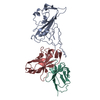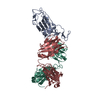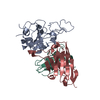[English] 日本語
 Yorodumi
Yorodumi- PDB-7swp: G32Q4 Fab in complex with SARS-CoV-2 Spike 6P (RBD local reconstr... -
+ Open data
Open data
- Basic information
Basic information
| Entry | Database: PDB / ID: 7swp | ||||||
|---|---|---|---|---|---|---|---|
| Title | G32Q4 Fab in complex with SARS-CoV-2 Spike 6P (RBD local reconstruction) | ||||||
 Components Components |
| ||||||
 Keywords Keywords | VIRAL PROTEIN/Immune System / antibody / virus / immunity / VIRAL PROTEIN / VIRAL PROTEIN-Immune System complex | ||||||
| Function / homology |  Function and homology information Function and homology informationMaturation of spike protein / viral translation / Translation of Structural Proteins / Virion Assembly and Release / host cell surface / host extracellular space / symbiont-mediated-mediated suppression of host tetherin activity / Induction of Cell-Cell Fusion / structural constituent of virion / entry receptor-mediated virion attachment to host cell ...Maturation of spike protein / viral translation / Translation of Structural Proteins / Virion Assembly and Release / host cell surface / host extracellular space / symbiont-mediated-mediated suppression of host tetherin activity / Induction of Cell-Cell Fusion / structural constituent of virion / entry receptor-mediated virion attachment to host cell / membrane fusion / Attachment and Entry / host cell endoplasmic reticulum-Golgi intermediate compartment membrane / positive regulation of viral entry into host cell / receptor-mediated virion attachment to host cell / host cell surface receptor binding / symbiont-mediated suppression of host innate immune response / receptor ligand activity / endocytosis involved in viral entry into host cell / fusion of virus membrane with host plasma membrane / fusion of virus membrane with host endosome membrane / viral envelope / virion attachment to host cell / SARS-CoV-2 activates/modulates innate and adaptive immune responses / host cell plasma membrane / virion membrane / identical protein binding / membrane / plasma membrane Similarity search - Function | ||||||
| Biological species |   Homo sapiens (human) Homo sapiens (human) | ||||||
| Method | ELECTRON MICROSCOPY / single particle reconstruction / cryo EM / Resolution: 3.8 Å | ||||||
 Authors Authors | Windsor, I.W. / Tong, P. / Wesemann, D.R. / Harrison, S.C. | ||||||
| Funding support |  United States, 1items United States, 1items
| ||||||
 Citation Citation |  Journal: Sci Immunol / Year: 2022 Journal: Sci Immunol / Year: 2022Title: Antibodies induced by an ancestral SARS-CoV-2 strain that cross-neutralize variants from Alpha to Omicron BA.1. Authors: Ian W Windsor / Pei Tong / Olivia Lavidor / Ali Sanjari Moghaddam / Lindsay G A McKay / Avneesh Gautam / Yuezhou Chen / Elizabeth A MacDonald / Duck Kyun Yoo / Anthony Griffths / Duane R ...Authors: Ian W Windsor / Pei Tong / Olivia Lavidor / Ali Sanjari Moghaddam / Lindsay G A McKay / Avneesh Gautam / Yuezhou Chen / Elizabeth A MacDonald / Duck Kyun Yoo / Anthony Griffths / Duane R Wesemann / Stephen C Harrison /  Abstract: Neutralizing antibodies that recognize the SARS-CoV-2 spike glycoprotein are the principal host defense against viral invasion. Variants of SARS-CoV-2 bear mutations that allow escape from ...Neutralizing antibodies that recognize the SARS-CoV-2 spike glycoprotein are the principal host defense against viral invasion. Variants of SARS-CoV-2 bear mutations that allow escape from neutralization by many human antibodies, especially those in widely distributed ("public") classes. Identifying antibodies that neutralize these variants of concern and determining their prevalence are important goals for understanding immune protection. To determine the Delta and Omicron BA.1 variant specificity of B cell repertoires established by an initial Wuhan strain infection, we measured neutralization potencies of 73 antibodies from an unbiased survey of the early memory B cell response. Antibodies recognizing each of three previously defined epitopic regions on the spike receptor binding domain (RBD) varied in neutralization potency and variant-escape resistance. The ACE2 binding surface ("RBD-2") harbored the binding sites of neutralizing antibodies with the highest potency but with the greatest sensitivity to viral escape; two other epitopic regions on the RBD ("RBD-1" and "RBD-3") bound antibodies of more modest potency but greater breadth. The structures of several Fab:spike complexes that neutralized all five variants of concern tested, including one Fab each from the RBD-1, -2, and -3 clusters, illustrated the determinants of broad neutralization and showed that B cell repertoires can have specificities that avoid immune escape driven by public antibodies. The structure of the RBD-2 binding, broad neutralizer shows why it retains neutralizing activity for Omicron BA.1, unlike most others in the same public class. Our results correlate with real-world data on vaccine efficacy, which indicate mitigation of disease caused by Omicron BA.1. | ||||||
| History |
|
- Structure visualization
Structure visualization
| Structure viewer | Molecule:  Molmil Molmil Jmol/JSmol Jmol/JSmol |
|---|
- Downloads & links
Downloads & links
- Download
Download
| PDBx/mmCIF format |  7swp.cif.gz 7swp.cif.gz | 92.6 KB | Display |  PDBx/mmCIF format PDBx/mmCIF format |
|---|---|---|---|---|
| PDB format |  pdb7swp.ent.gz pdb7swp.ent.gz | 65.5 KB | Display |  PDB format PDB format |
| PDBx/mmJSON format |  7swp.json.gz 7swp.json.gz | Tree view |  PDBx/mmJSON format PDBx/mmJSON format | |
| Others |  Other downloads Other downloads |
-Validation report
| Summary document |  7swp_validation.pdf.gz 7swp_validation.pdf.gz | 862.6 KB | Display |  wwPDB validaton report wwPDB validaton report |
|---|---|---|---|---|
| Full document |  7swp_full_validation.pdf.gz 7swp_full_validation.pdf.gz | 882.8 KB | Display | |
| Data in XML |  7swp_validation.xml.gz 7swp_validation.xml.gz | 26.2 KB | Display | |
| Data in CIF |  7swp_validation.cif.gz 7swp_validation.cif.gz | 37.5 KB | Display | |
| Arichive directory |  https://data.pdbj.org/pub/pdb/validation_reports/sw/7swp https://data.pdbj.org/pub/pdb/validation_reports/sw/7swp ftp://data.pdbj.org/pub/pdb/validation_reports/sw/7swp ftp://data.pdbj.org/pub/pdb/validation_reports/sw/7swp | HTTPS FTP |
-Related structure data
| Related structure data |  25478MC  7swnC  7swoC M: map data used to model this data C: citing same article ( |
|---|---|
| Similar structure data | Similarity search - Function & homology  F&H Search F&H Search |
- Links
Links
- Assembly
Assembly
| Deposited unit | 
|
|---|---|
| 1 |
|
- Components
Components
| #1: Protein | Mass: 21901.570 Da / Num. of mol.: 1 Source method: isolated from a genetically manipulated source Source: (gene. exp.)  Gene: S, 2 / Cell line (production host): expi293F / Production host:  Homo sapiens (human) / References: UniProt: P0DTC2 Homo sapiens (human) / References: UniProt: P0DTC2 |
|---|---|
| #2: Antibody | Mass: 25261.164 Da / Num. of mol.: 1 Source method: isolated from a genetically manipulated source Source: (gene. exp.)  Homo sapiens (human) / Cell line: expi293F / Production host: Homo sapiens (human) / Cell line: expi293F / Production host:  Homo sapiens (human) Homo sapiens (human) |
| #3: Antibody | Mass: 22804.156 Da / Num. of mol.: 1 Source method: isolated from a genetically manipulated source Source: (gene. exp.)  Homo sapiens (human) / Cell line: expi293F / Production host: Homo sapiens (human) / Cell line: expi293F / Production host:  Homo sapiens (human) Homo sapiens (human) |
| Has protein modification | Y |
-Experimental details
-Experiment
| Experiment | Method: ELECTRON MICROSCOPY |
|---|---|
| EM experiment | Aggregation state: PARTICLE / 3D reconstruction method: single particle reconstruction |
- Sample preparation
Sample preparation
| Component | Name: C98C7 Fab in complex with WT SARS-CoV-2 RBD / Type: COMPLEX / Entity ID: all / Source: MULTIPLE SOURCES |
|---|---|
| Molecular weight | Experimental value: NO |
| Source (natural) | Organism:  |
| Buffer solution | pH: 7.5 |
| Specimen | Conc.: 0.7 mg/ml / Embedding applied: NO / Shadowing applied: NO / Staining applied: NO / Vitrification applied: YES |
| Vitrification | Cryogen name: ETHANE |
- Electron microscopy imaging
Electron microscopy imaging
| Experimental equipment |  Model: Titan Krios / Image courtesy: FEI Company |
|---|---|
| Microscopy | Model: FEI TITAN KRIOS |
| Electron gun | Electron source:  FIELD EMISSION GUN / Accelerating voltage: 300 kV / Illumination mode: FLOOD BEAM FIELD EMISSION GUN / Accelerating voltage: 300 kV / Illumination mode: FLOOD BEAM |
| Electron lens | Mode: BRIGHT FIELD / Nominal defocus max: 1800 nm / Nominal defocus min: 600 nm |
| Image recording | Electron dose: 52.9 e/Å2 / Film or detector model: GATAN K3 BIOQUANTUM (6k x 4k) |
- Processing
Processing
| Software | Name: PHENIX / Version: 1.18.2_3874: / Classification: refinement | ||||||||||||||||||||||||
|---|---|---|---|---|---|---|---|---|---|---|---|---|---|---|---|---|---|---|---|---|---|---|---|---|---|
| EM software | Name: RELION / Version: 3.1 / Category: 3D reconstruction | ||||||||||||||||||||||||
| CTF correction | Type: PHASE FLIPPING AND AMPLITUDE CORRECTION | ||||||||||||||||||||||||
| 3D reconstruction | Resolution: 3.8 Å / Resolution method: FSC 0.143 CUT-OFF / Num. of particles: 1033260 / Symmetry type: POINT | ||||||||||||||||||||||||
| Refine LS restraints |
|
 Movie
Movie Controller
Controller




 PDBj
PDBj




